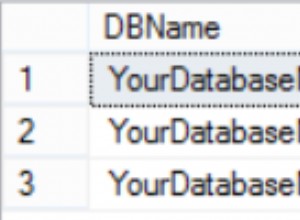Wyobraź sobie swój stół test zawiera następujące dane:
select id, email
from test;
ID EMAIL
---------------------- --------------------
1 aaa
2 bbb
3 ccc
4 bbb
5 ddd
6 eee
7 aaa
8 aaa
9 eee
Musimy więc znaleźć wszystkie powtarzające się e-maile i usunąć je wszystkie, ale najnowszy identyfikator.
W tym przypadku aaa , bbb i eee są powtarzane, więc chcemy usunąć identyfikatory 1, 7, 2 i 6.
Aby to osiągnąć, najpierw musimy znaleźć wszystkie powtarzające się e-maile:
select email
from test
group by email
having count(*) > 1;
EMAIL
--------------------
aaa
bbb
eee
Następnie z tego zbioru danych musimy znaleźć najnowszy identyfikator dla każdego z tych powtarzających się e-maili:
select max(id) as lastId, email
from test
where email in (
select email
from test
group by email
having count(*) > 1
)
group by email;
LASTID EMAIL
---------------------- --------------------
8 aaa
4 bbb
9 eee
Wreszcie możemy teraz usunąć wszystkie te e-maile z identyfikatorem mniejszym niż LASTID. Rozwiązaniem jest więc:
delete test
from test
inner join (
select max(id) as lastId, email
from test
where email in (
select email
from test
group by email
having count(*) > 1
)
group by email
) duplic on duplic.email = test.email
where test.id < duplic.lastId;
Nie mam w tej chwili zainstalowanego mySql na tym komputerze, ale powinien działać
Aktualizacja
Powyższe usuwanie działa, ale znalazłem bardziej zoptymalizowaną wersję:
delete test
from test
inner join (
select max(id) as lastId, email
from test
group by email
having count(*) > 1) duplic on duplic.email = test.email
where test.id < duplic.lastId;
Widać, że usuwa najstarsze duplikaty, tj. 1, 7, 2, 6:
select * from test;
+----+-------+
| id | email |
+----+-------+
| 3 | ccc |
| 4 | bbb |
| 5 | ddd |
| 8 | aaa |
| 9 | eee |
+----+-------+
Inną wersją jest usuwanie dostarczone przez Rene Limon
delete from test
where id not in (
select max(id)
from test
group by email)




